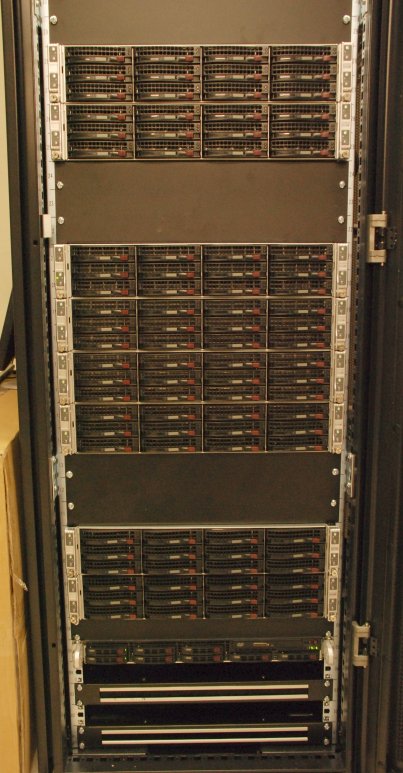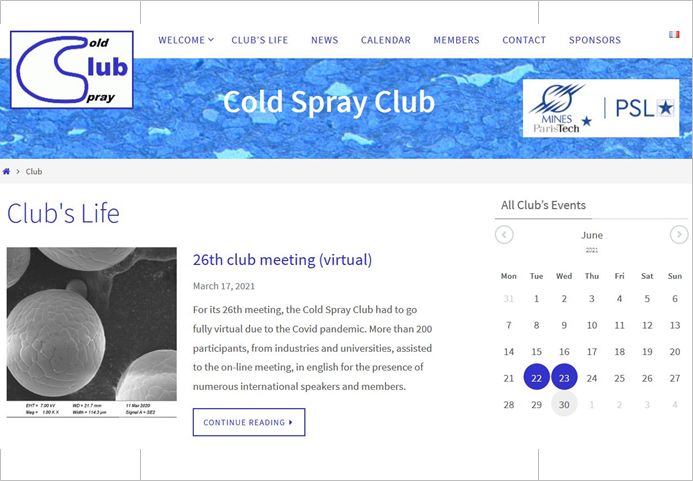



 Lecture
Lecture
Bio-based aerogels: new eco-friendly porous materials for thermal insulation and controlled release
The term cluster designates a group of independent computers, referred to as nodes that are all interconnected via a dedicated network. In this way, the machine is capable of processing very large-scale problems by using the accumulated power of its various nodes.
For some six years, the Centre des Matériaux has been actively developing parallel computations algorithms and techniques. This activity received a boost in August 2005 with the purchase of a new computer cluster based on Opteron 64-bit processors.
This equipment was acquired thanks to the financial support of the Conseil Général de l'Essonne and the Conseil Régional d'Ile-de-France, within the framework of a project coordinated by the Fédération Ile-de-France Sud «Mécanique et Matériaux».
 Technical Description
Technical DescriptionWith its original specifications, the theoretical power of the cluster is 10 times less than the leading French machine and 500 times inferior to the leading machine in the world. Nevertheless, it rates among the 2,000 largest computers in the world.
In the mechanics of materials and structures area, industrial demand has led to increasingly more computer intensive simulations due to the use of increasingly complex constitutive material models as well as the need to refine further the geometry of components and the level of detail of microstructure models. Calculations are no longer possible to be performed on traditional machines within a reasonable CPU time. Instead, they can be perfomed in just a few days on the new supercomputer for non-linear calculations of up to several millions degrees of freedom. The method of parallel computations retained is based on a restructuring of the unknown fields and on an iterative resolution of the interface problem (FETI method). It adapts perfectly to the configuration of the machine which has a distributed memory. Some of the development work is conducted in cooperation with the research divisions from ONERA and ENS Cachan.
For calculating the blades of an aero engine gas turbine (c.f. figures attached), we have moved from a simple simulated cross-section with an isotropic model of the blade material to 3D simulations which take account ofthe single-crystal nature of the material and of the real local geometry. However, the local fields around cooling holes have not yet been represented in satisfactory fashion. Undertaking such calculations without any simplifying hypothesis requires the meshing of the blade using several million nodes, which the current cluster now enables us to do.
In addition to aerospace structures, other applications concerned are those of energy (thermal and nuclear power plants), transport (road and rail), as well as micro-electronics (residual stress in circuits and semiconductor devices) and emerging technologies (hydrogen storage and fuel cells, biomaterials).
Present as they have been in the literature since the 1990s, calculations of policrystal aggregates were first aimed at determining the average behaviour of homogeneous materials. Following the progress made in developing improved techniques to measure surface strains, it is now possibly to obtain information at the level of each individual phase. The current trend seeks to describe local fields at the microstructural scale in order to provide relevant critical variables for deformation, damage and crack initiation models. The figure attached represents the result of an FE calculation on a copper polycrystal, comprising approximately 2 million nodes.

A new version of the COLD SPRAY CLUB website is now…
The COLD SPRAY CLUB concerns laboratories, technology…
> En savoir +

Formation
A MINES ParisTech PhD student awarded at the…
Josiane Nguejio, PhD student at Centre des Matériaux…
> En savoir +

Recherche
The FEMS Lecturers 2014-2015 include Henry PROUDHON
Lecturer Series This is a scheme which sponsors selected…
> En savoir +

Recherche
award for a team of Centre des Matériaux
Nicolas Gueninchault who work in teams M2 and COCAS with Henry…
> En savoir +
Recherche
The SF2M award three medals to doctors of the centre des…
The medal Réaumur is given by SF2M, each two…
> En savoir +
